Checking in on the redevelopment in Albany's Sheridan Hollow neighborhood
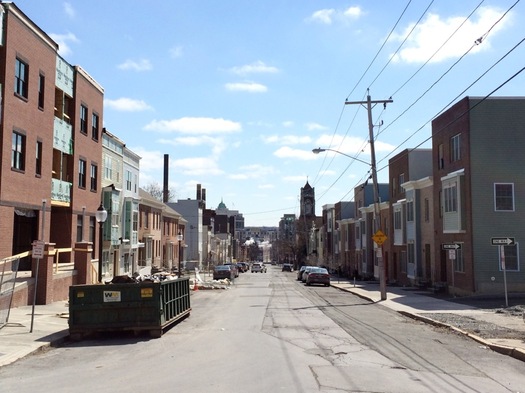
Sheridan Avenue in Sheridan Hollow, looking east toward downtown Albany.
The most interesting real estate project in Albany -- and maybe the whole Capital Region -- has completed its first phase and is now moving onto phase two.
Habitat for Humanity Capital District and a group of partners recently finished building 14 new homes in the Sheridan Hollow neighborhood, and work has already started on another 10 new homes nearby on Orange and Lark streets. At the same time, an org called Housing Visions is building 57 new residential rental units, along with mixed-use space that will include offices and a cafe.
So, what's next? And how does this fit in with downtown Albany's ongoing residential transformation? We stopped by the project this week for a walk and talk with Habitat for Humanity Capital District executive director Christine Schudde.
Now that part of the project is in place, are you seeing it differently or has your perspective changed on it?
I think something that's followed for me as we've been working in Sheridan Hollow is that when you first look at the statistics of the neighborhood -- which is how we got started with this, the University at Albany had come out with a report I think in 2010 about the neighborhood, just saying what the vacancy rate is and the homeownership rate is -- and when you just look at those numbers it's really easy to say, 'Oh, Sheridan Hollow, there wasn't much here. There weren't a lot of homeowners and there's a lot of vacant land, and a lot of land used for parking lots.' And it'd be easy to say there's nothing here, a blank slate, let's build a lot of houses.
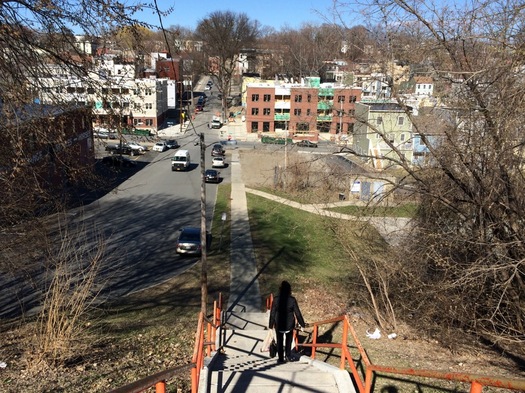
Looking into Sheridan Hollow from the Dove Street steps. Those two large buildings on the far corners are the mixed-use buildings being constructed by Housing Visions. Habitat for Humanity Capital District will be moving its offices to the one of the left. A restaurant called The Hungry Hollow will be taking space in the one on the right.
Really, that's not the case. And anyone who lives in the neighborhood or works in the neighborhood could have told you that's not the case. It's an overlooked neighborhood -- a physically overlooked neighborhood, it's actually in a ravine. But it has a thriving neighborhood association, a lot of really great groups, it has entrepreneurs here, people starting community gardens. There's a lot already happening here, and a lot that will continue to happen here, with or without Habitat. So we just hope that we can continue building in a way that is responsive to the community, that offers better homeownership opportunities.
Because there really weren't a lot of homeownership opportunities. There are some older buildings here that to purchase and renovate would cost a lot of money, which is just out of reach for most people -- especially knowing the housing market, that you won't be able to sell it for as much as you put into it.
So at Habitat, we say we're not building the community, it's already here. But we can help increase affordable housing options, help attract homeowners who already live here and were renting, or people who are in interested in in Sheridan Hollow but hadn't looked at it before. If we can attract people to the neighborhood -- and incentivize people to stay in the neighborhood so that they don't get pushed out by high prices -- if we can do that, I think that's probably the best role we can have in Sheridan Hollow.
You've now moved on to not just building new homes, but rehabbing properties. What is the thinking behind doing that?
Sheridan Hollow had so much land that we could build new construction on. And it makes a lot of sense. It makes a huge impact when you can quickly show something's happening here, investment's happening here. But it doesn't make sense to build beautiful new homes and then across the street you have boarded up homes.
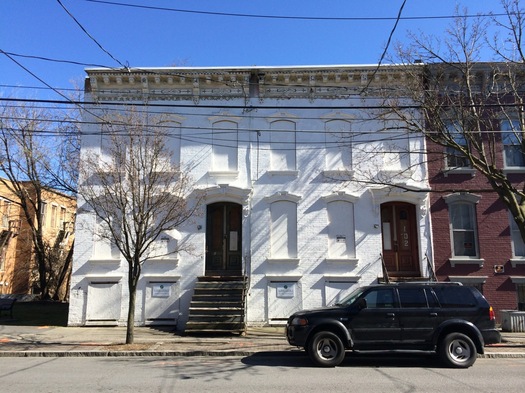
Habitat is working with the Albany County Land Bank to rehab five homes in the neighborhood, including these two on Lark Street. The land bank will continue to own the properties, Habitat will be acting as the developer and handle the sale of them.
And Albany, like so many other upstate cities, there are so many old homes here. There are so many homes the last 15-20 years that have been left to fall into disrepair, but aren't too far gone and there are ones that we can still save. You can't save every building, but you can save a lot of them.
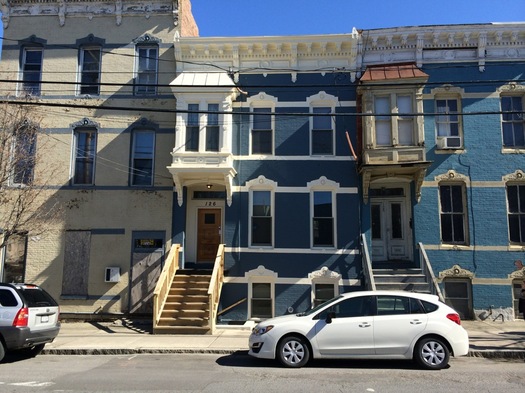
Habitat rehabbed the blue building in the middle in 2015 as part of a separate project.
If we're looking at real community development, and looking holistically at a neighborhood, then you have to address the houses that are already there. And you have to bring them back to life, too. It wouldn't be enough to just build new houses. That's enough to make sure families have a place to live -- but it's not enough to help bring back a neighborhood, or strengthen a neighborhood.
There's a lot of market-rate development in downtown Albany over the last few years. A lot of it has been not just market rate, but higher-end development. And what's amazing about this site is that it's literally just a couple of blocks from there, you can actually see some of those developments from here. So how does what's going on here fit with this wider picture of downtown Albany's residential change?
Yeah, it fits beautifully with the downtown residential trends that are happening here. We're just two blocks away from 17 Chapel condominiums, from The Monroe, from everything that's happening on North Pearl Street and Broadway. It's a 10-minute walk, it's nothing strenuous. And it's less than a 10-minute walk from the Center Square neighborhood -- you can go right up the staircase from Sheridan Ave and get on to Elk Street really quickly.
We think the downtown residential trend and investment is fantastic. We are completely supporters of that, we want more people to live in downtowns. But we want to make sure it's not just folks of means who can afford to live downtown. And that families, particularly those who have been in these neighborhoods for many generations, we want to make sure that they can stay here and afford to put down roots, and to still live near where they work so they can have good work-life balance, that their kids can stay in the schools they want to be in.

Schudde says the Habitat homes have been sold for $125,000-$145,000 for single-family homes, and $150,000-$160,000 for two-families. "The population that we're trying to serve are households that aren't currently served by public solutions or by the market. People who typically wouldn't be able to afford or to be approved for a conventional mortgage, but are either earning more than, or just beyond the point where public housing or a Section 8 voucher would help them. So it's a sort of a sweet spot, and it's higher than a lot of people would think. For a single-family house, say it's $125,000. A family of three can earn well into the $60,000s and still qualify for a Habitat house. Which is a lot higher than what I think a lot of people are expecting, but it's also kind of shocking that a family earning that much can't qualify for a traditional mortgage elsewhere."
So we really see it as a partnership. The fact is that the more market-rate and higher-end apartments and condos that are here, the more services the neighborhood would attract. We wish it weren't necessarily the case. But if you have people with a little more disposable income that attracts more services and retail to the area, it helps everyone.
I think the timing of what we're doing is really perfect, too, because we're able to sort of stake a claim for families who otherwise wouldn't be able to afford to live downtown.
Do you have any hopes for the effect of the projects concentrated here, beyond the fact that they're providing a place for people to live and own?
I think this project has demonstrated, and will continue to show, a few things. One is that you can have affordable housing that is beautiful, that is energy efficient, that blends in with the rest of the neighborhood, and just from an aesthetic perspective is desirable. That you don't have to segregate it geographically, you don't have to segregate the homes by how they look. You can have this sort of mixed-income community. And I think Sheridan -- because there is that market rate, sort of luxury development happening so close by -- I think it would be a really good model for a diverse, thriving neighborhood.
We're not the only piece of it, but we think because we're trying to blend our houses into the neighborhood and because Habitat homeowners are working for city government and working for major corporations and schools here, they're working alongside a lot of other people who are living in the neighborhood. And we think Sheridan can be a really great example of how you can integrate these different housing types and how you can help develop a more sustainable base of downtown residents.
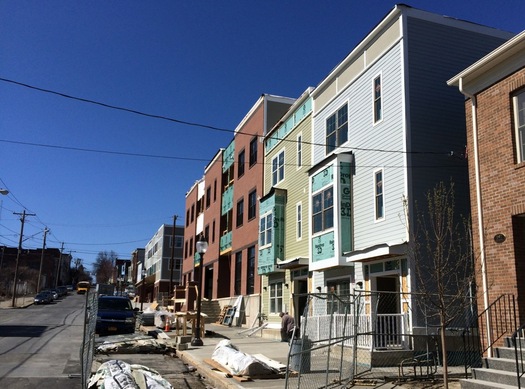
Two of the residential buildings being constructed by Housing Visions in the foreground, and the mixed-use buildings in the background.
One of the things about this project is that it's demonstrated for people around here that Habitat is not just the place that builds a house on the weekend with volunteers. So where does Habitat go from here?
I think from here we can continue to grow in production. We certainly haven't reached the peak of what we can do. But we are trying to find that focus and figure out how many different neighborhoods we can build in at once. And does it make sense to say, OK, for the next two years we're building in Sheridan Hollow/Arbor Hill, or to spread out a little bit more? And because we're not a one-house-at-a-time Habitat -- of which there are many throughout the country, and many of those affiliates don't have staff, so it's impressive that they're building a house a year -- because we're a major developer and a major affordable home builder it's incumbent for us to figure out our role in the broad community development.
We care tremendously about many different issues that are facing the neighborhoods we work in: access to food, and transportation, park space, things like this that are so important to a neighborhood. So we are figuring out what our role can be in that. And in some cases it's a leading role, and in some cases it's supporting other efforts that are happening. But we do want to make sure we're focused on broader community development, but in a way that makes sense for Habitat.
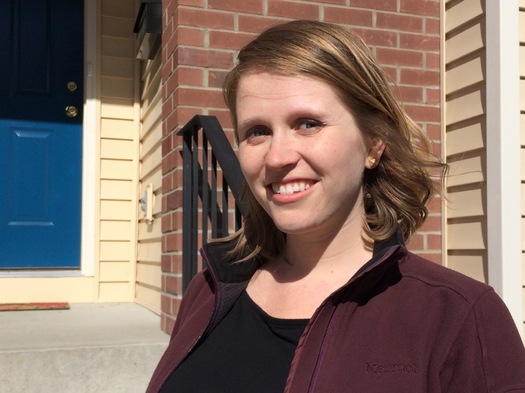
Habitat for Humanity Capital District executive director Christine Schudde, outside one of the new homes on Sheridan Ave built by Habitat.
You and your husband are now homeowners.
Yes, we are! In the last year, yeah. (laughing)
So now that you own your own home, has that changed the way you look at your job?
Absolutely. You really do have a sense of pride, a sense of investment. And I've lived in many neighborhoods in Albany, I've lived in the city of Albany for a long time. But now that I own a house in the neighborhood, you're sort of looking around and wanting to make sure everyone's doing the right thing at their houses, too.
It's also a huge responsibility and that's something we try prepare our homebuyers for as much as possible. There's an extensive financial education course that homeowners complete, that, you know, I'm taking alongside them because I'm a new homeowner, too. But it a huge responsibility going from being able to call a landlord to fix something to knowing you have to figure out how to fix that leaking water heater in the middle of night.
But it's a lot of fun. And it does feel like I'm on a journey will all of our homebuyers, too.
This interview has been edited and condensed.
____
Earlier on AOA:
+ Constructing a new future for Sheridan Hollow
+ Sheridan Hollow, before and during
Say Something!
We'd really like you to take part in the conversation here at All Over Albany. But we do have a few rules here. Don't worry, they're easy. The first: be kind. The second: treat everyone else with the same respect you'd like to see in return. Cool? Great, post away. Comments are moderated so it might take a little while for your comment to show up. Thanks for being patient.
Comments
This could have happened a lot earlier if Albany's wonderful incinerator had been taken off line earlier.
... said ace on Mar 31, 2016 at 2:34 PM | link
Habitat of the Capital District is an amazing organization run by an amazing young woman. I foresee continued success and growth for both. Go Christine!
... said Bancroftguy on Mar 31, 2016 at 5:59 PM | link
Awesome project for an area that needed this kind of involvement to create decent affordable properties. Hope they keep selling these to people with reasonable incomes who should be homeowners and I hope this kind of development continues across Clinton. It's desperately needed over there and not many people willing to invest. There's just no cash flow or ROI over there.
... said Michael on Apr 1, 2016 at 2:29 PM | link
Great Organization that is cost effective and changes lives and communities. A real gem for Albany.
... said albanylandlord on Apr 1, 2016 at 11:14 PM | link
Great work by HFH and all the other partners who are presently involved or will be in the near future. I was a little worried that such a massive overhaul of this neighborhood would no doubt miss a lot of key points and ignore may concerns of those who presently reside there (aka the Park South development, which ignored many of the desired outcomes from its residents, in favor or appeasing the suburbanites commuting in and out). However, this development has been holistic in nature and to scale, and promise to offer the type of mix-used, and more importantly, mix-income development that has proven successful in Europe and those American cities that have engaged in such endeavors. Cheers to all involved and continued success!!
... said Bill on Apr 2, 2016 at 8:35 AM | link